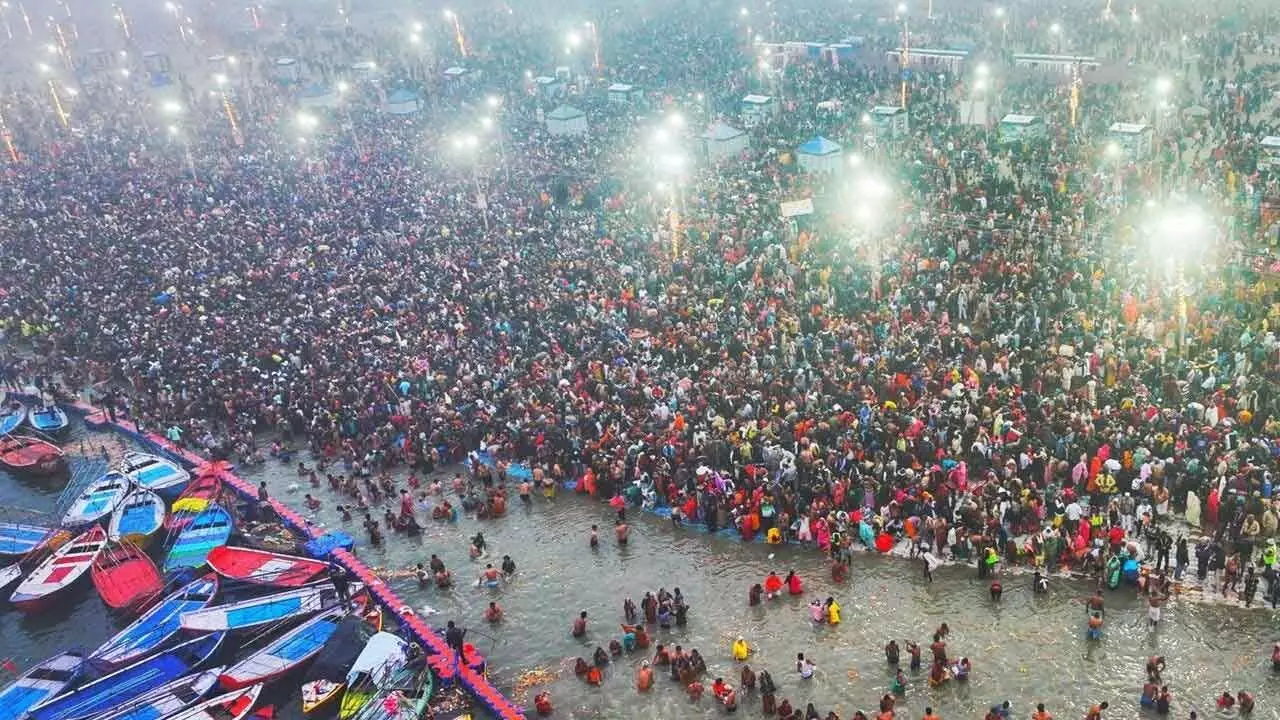The Invisible Thread: What Drives Millions To Kumbh?
From the ancient chants resonating in the air to the meticulous self-organization of millions, the event embodies the spiritual essence of Sanatan Dharma
The Invisible Thread: What Drives Millions To Kumbh?

Pilgrims from across the globe come together in unison, driven by a timeless connection to the sacred waters of the Triveni. Maha Kumbh 2025 is a testament to the enduring power of belief, transforming Prayagraj into a living testament of devotion and unity
Aastha is the soul of the Maha khumbh. Drawn by Shraddha (faith) and Bhakti (devotion), millions of people from every corner of Bharat and the world shall be converging at the Triveni- the holy intersection of three mighty rivers—the Ganga, Yamuna, and the invisible Saraswati.
Without a prayer call or organized command, crores of people move in unison, crossing cities, towns, and villages and congregating at Prayagraj to take a holy dip at the Sangam during the Brahma Muhurat. It is as if the stars align not just in the heavens but within the hearts of the devotees.
My wife, son and I were blessed to be at the Mahakhumb of 2025 on its very first day, January 13. We reached Prayagraj on January 12, late hours and stayed at the tent city, which is about three kilo meters from the Triveni. The next day, on January 13, we woke up at 4 AM and, after a quick shower, joined the moving sea of humanity. The air was filled with chants of "Har Har Gange" and "Om Namah Shivaya." The atmosphere vibrated with devotion.
As we walked, we saw people carrying their belongings—some had just arrived, while others had spent nights under the open sky, waiting for this moment. We crossed the ancient Shri Naga Vaasuki Temple, feeling the chill of the river breeze as we moved closer to the Sangam. The roads, once rough and dusty, were now paved, making the journey smoother for the endless stream of devotees. The further we walked, the more people joined. What had started as a group of hundreds soon swelled to thousands.
The Devotees armed with selfie sticks and smartphones captured every moment, documenting their spiritual journey. The closer we got to the Triveni, the denser the crowd became. Yet, there was no jostling, no panic—just a shared purpose. People were not here just for the dip; they were here to absorb the experience, to live every moment of this divine gathering. Some chanted mantras, some played drums, and others simply walked in silence, their eyes reflecting the spiritual energy surrounding them.
A micro-economy thrived along the path. Vendors sold bottles ranging from 200 ml to 5 litres for devotees to collect the sacred water. Families sold small paper boats with diyas and flowers, ready to be floated on the river as offerings. Coconuts wrapped in red cloth were being handed over to those who wished to offer them to holy rivers. Chai vendors served steaming cups of tea, and herbal toothbrushes made from neem stems were available for those who wished to follow ancient traditions.
As we neared the ghat, we noticed how well-organized everything was. Metal sheets covered the pathways, preventing the sand from loosening under the constant movement of people. Policemen and NCC cadets directed the crowds, ensuring a smooth flow. The final stretch was marked by floating barricades, ensuring that no one ventured too far into the river’s depths. The banks were lined with sandbags to prevent slipping, and changing rooms were available for those emerging from their sacred dip.
Standing at the water’s edge, I watched as men, women, children, and even the elderly prepared for their holy dip. The air was thick with devotion. Some took three dips in the river; others offered water to the rising sun. Diyas flickered on the water’s surface, coconuts drifted away with prayers attached to them, and priests performed rituals for those seeking blessings for their ancestors.
As I stepped into the river, the icy water sent shivers through my body. But at that moment, I felt connected—not just to the river but to something much greater, something eternal. I immersed myself thrice, each time emerging with a renewed sense of peace. Offering my prayers to Surya Dev and the trinity, I released a diya into the water, watching it float away like a messenger carrying my wishes to the divine. On the way back, I was struck by a single thought: How is it that crores of people, without any official summons, simply rise from their homes and embark on this journey? It is not just tradition—it is something embedded deep within our DNA. Some families have been coming here for generations; for others like me, it was the first time. Yet, we all moved as one, bound by an invisible thread of faith.
Families devised their own ways to stay together—elders were tied to the ablest member of the family with a thread, children were ring-fenced within a protective circle of relatives, and groups followed a designated flag bearer to ensure no one was lost. Despite the massive crowd, there was no chaos. It was all self-organized, driven by Shraddha, Bhakti, and an unshakable faith in Sanatan Dharma.
The Maha Khumb is more than an event—it is a testament to the power of belief. It is the faith of millions that breathes life into this divine gathering, making it one of the most extraordinary spectacles of human devotion in the world.
(The author is Founder of
My Startup TV)

